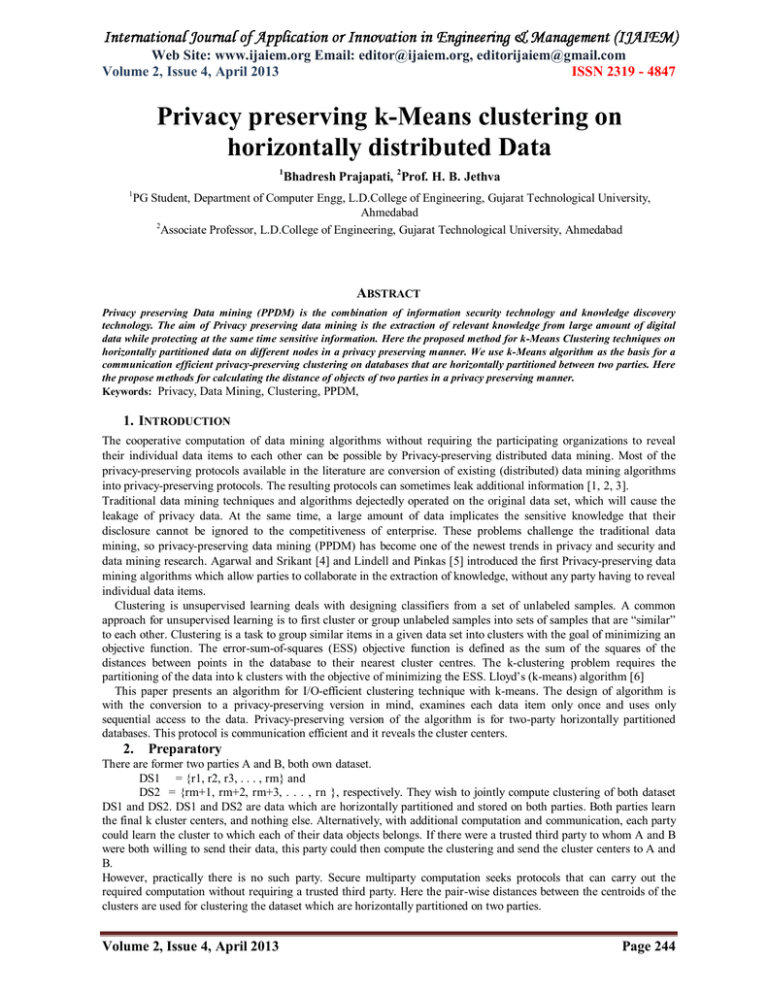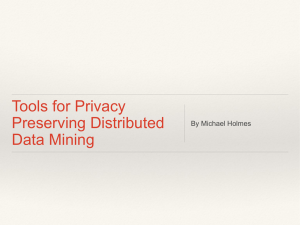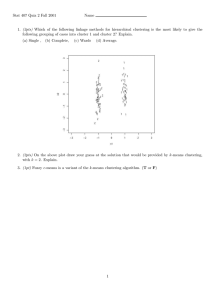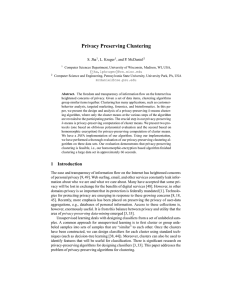Privacy preserving k-Means clustering on horizontally distributed Data
advertisement

Web Site: www.ijaiem.org Email: editor@ijaiem.org, editorijaiem@gmail.com
Volume 2, Issue 4, April 2013
ISSN 2319 - 4847
Privacy preserving k-Means clustering on
horizontally distributed Data
1
1
Bhadresh Prajapati, 2Prof. H. B. Jethva
PG Student, Department of Computer Engg, L.D.College of Engineering, Gujarat Technological University,
Ahmedabad
2
Associate Professor, L.D.College of Engineering, Gujarat Technological University, Ahmedabad
ABSTRACT
Privacy preserving Data mining (PPDM) is the combination of information security technology and knowledge discovery
technology. The aim of Privacy preserving data mining is the extraction of relevant knowledge from large amount of digital
data while protecting at the same time sensitive information. Here the proposed method for k-Means Clustering techniques on
horizontally partitioned data on different nodes in a privacy preserving manner. We use k-Means algorithm as the basis for a
communication efficient privacy-preserving clustering on databases that are horizontally partitioned between two parties. Here
the propose methods for calculating the distance of objects of two parties in a privacy preserving manner.
Keywords: Privacy, Data Mining, Clustering, PPDM,
1. INTRODUCTION
The cooperative computation of data mining algorithms without requiring the participating organizations to reveal
their individual data items to each other can be possible by Privacy-preserving distributed data mining. Most of the
privacy-preserving protocols available in the literature are conversion of existing (distributed) data mining algorithms
into privacy-preserving protocols. The resulting protocols can sometimes leak additional information [1, 2, 3].
Traditional data mining techniques and algorithms dejectedly operated on the original data set, which will cause the
leakage of privacy data. At the same time, a large amount of data implicates the sensitive knowledge that their
disclosure cannot be ignored to the competitiveness of enterprise. These problems challenge the traditional data
mining, so privacy-preserving data mining (PPDM) has become one of the newest trends in privacy and security and
data mining research. Agarwal and Srikant [4] and Lindell and Pinkas [5] introduced the first Privacy-preserving data
mining algorithms which allow parties to collaborate in the extraction of knowledge, without any party having to reveal
individual data items.
Clustering is unsupervised learning deals with designing classifiers from a set of unlabeled samples. A common
approach for unsupervised learning is to first cluster or group unlabeled samples into sets of samples that are “similar”
to each other. Clustering is a task to group similar items in a given data set into clusters with the goal of minimizing an
objective function. The error-sum-of-squares (ESS) objective function is defined as the sum of the squares of the
distances between points in the database to their nearest cluster centres. The k-clustering problem requires the
partitioning of the data into k clusters with the objective of minimizing the ESS. Lloyd’s (k-means) algorithm [6]
This paper presents an algorithm for I/O-efficient clustering technique with k-means. The design of algorithm is
with the conversion to a privacy-preserving version in mind, examines each data item only once and uses only
sequential access to the data. Privacy-preserving version of the algorithm is for two-party horizontally partitioned
databases. This protocol is communication efficient and it reveals the cluster centers.
2.
Preparatory
There are former two parties A and B, both own dataset.
DS1 = {r1, r2, r3, . . . , rm} and
DS2 = {rm+1, rm+2, rm+3, . . . , rn }, respectively. They wish to jointly compute clustering of both dataset
DS1 and DS2. DS1 and DS2 are data which are horizontally partitioned and stored on both parties. Both parties learn
the final k cluster centers, and nothing else. Alternatively, with additional computation and communication, each party
could learn the cluster to which each of their data objects belongs. If there were a trusted third party to whom A and B
were both willing to send their data, this party could then compute the clustering and send the cluster centers to A and
B.
However, practically there is no such party. Secure multiparty computation seeks protocols that can carry out the
required computation without requiring a trusted third party. Here the pair-wise distances between the centroids of the
clusters are used for clustering the dataset which are horizontally partitioned on two parties.
Volume 2, Issue 4, April 2013
Page 244
Web Site: www.ijaiem.org Email: editor@ijaiem.org, editorijaiem@gmail.com
Volume 2, Issue 4, April 2013
ISSN 2319 - 4847
3. PRIVACY-PRESERVING CLUSTERING ALGORITHM
3.1 Distributed clustering algorithm DK-Means
Distributed clustering algorithm DK-Means is proposed by Zheng Miaomiao [2], ect., which improves the K-Means
algorithm, that is, the site in the clustering process does not require transferring large amounts of data objects, only
needs to send the clustering centers as well as the total number of clusters of data objects, which reduces data traffic of
the distributed clustering process so as to improve operating efficiency. This strategy would be applied on the database
into two different parties, recursively produce k cluster centers from each of the party, and then merge these 2k centers
into the k final centers. We do this by repeatedly choosing a best pair of clusters Ci and Cj for merging, and replacing
them in the clustering with Ci U Cj.
The k-means cluster algorithm will do the three steps below until convergence on both parties.
Iterates until stable (= no object move group):
1. Determine the centroids coordinates
2. Determine the distance of each object to the centroid
3. Group the object based on the minimum distance.
A best pair of clusters is one with least error. Suppose C1 and C2 be two clusters being considered for a merge and C.w
denote the number of objects in cluster C then. In [7] the error of C1 U C2 is
where dist(C1,C2) is the distance between the centers of C1 and C2 .
3.2 Subroutine MergeCenters
1. S1= Cluster (DS1,k)
2. S2= Cluster(DS2, k)
(S1 and S2 are Cluster Centers)
3. S is Merge Centers ( S1U S2, k)
4. Input Cluster centers S, Integer k
5. While (|S| > k)
i. Compute the merge error for all pairs of centers in S.
ii. Remove from S the pair with the lowest merge error,
and insert the center of the merged cluster, with its weight as the sum of the weights of the pair.
6. Output Cluster centers S such that |S| = k
3.3 Algorithm to calculate distance for k-means Clustering with Privacy-preservation on horizontally
distributed data
The protocol will be for three participants:
Volume 2, Issue 4, April 2013
Page 245
Web Site: www.ijaiem.org Email: editor@ijaiem.org, editorijaiem@gmail.com
Volume 2, Issue 4, April 2013
ISSN 2319 - 4847
- Parties D1 and D2 of Dataset owner DS1 and DS2 respectively and the third party (TP).
- The parties D1 and D2 want to compute the distance between two centroid Ci and Cj, held by each site
respectively, then
The protocol for computing the distance between Ci and Cj without using their original values by TP works as
follows:
At site D1
- Random number r12 and r1T are generated then sends r 12 to D2 , r 1T to TP.
If the generated random number r12 is odd, then
D negates its input value as x’= - x otherwise x’=x
1
- D1 send x’’= (r1T + x’) to D2.
At site D2
- If the generated random number r12 is even, then
D2 negates its input value as y’= -y otherwise y’= y.
- D2 sends m=(x’’+ y’) to TP,
At site TP
- Distance (x , y) = (m- r1T)
(x and y are values of attributes values of site D1 and D2 respectively.)
3.4 Algorithm to merge Clusters which found minimum error with preserving Privacy.
The protocol for merging cluster Ci and Cj without using their original values by TP works as follows:
At site D1
- Random number r1T is generated then sends r1T to TP.
- D1 send x’= (x*Ci.w - r1T ) to D2.
At site D2
- D2 sends m=(x’+ y*Cj.w) to TP,
At site TP
- Merged value of M = (m + r1T)
- Average value of M is calculated using no of rows in each clusters.
(x and y are values of attributes values of site D1 and D2 respectively.)
Here the random numbers used in protocol is generated by pseudo-random number generators. Our comparison
protocol preserves privacy as long as a high quality pseudo-random number generator, that has a long period and that is
not predictable, is used and it is secured [8].
4. CONCLUSION
This paper probes the privacy-preserving of distributed clustering data mining and proposes a horizontal partitioned
clustering privacy-preserving algorithm, which, through the effective combination of secure multi-party computation
and clustering algorithm, not only well hides the sensitive data in clustering mining process to realize privacypreserving but also protects the results of clustering mining from influencing to realize the accuracy of results.
5. ACKNOWLEDGEMENT
Bhadresh G. Prajapati would like to thank to my guide Prof. H. B. Jethva for his great effort and instructive comments
in this paper work. Lastly, I wish to thank to all those who helped me during my research work
References
[1] J. Vaidya and C. Clifton, Privacy-preserving k-means clustering over vertically partitioned data, In 9th KDD
2003.
Volume 2, Issue 4, April 2013
Page 246
Web Site: www.ijaiem.org Email: editor@ijaiem.org, editorijaiem@gmail.com
Volume 2, Issue 4, April 2013
ISSN 2319 - 4847
[2] G. Jagannathan and R.Wright, Privacy-preserving distributed k-means clustering over arbitrarily partitioned data,
In 11th KDD, pages 593–599, 2005.
[3] S. Jha, L. Kruger, and P. McDaniel, Privacy preserving clustering, In 10th ESORICS, 2005.
[4] R. Agrawal and R. Srikant, Privacy-preserving data mining, In ACM SIGMOD, pages 439–450, May 2000
[5] Y. Lindell and B. Pinkas, Privacy preserving data mining, J. Cryptology, 15(3):177–206, 2002.
[6] S. P. Lloyd, Least squares quantization in PCM, IEEE Trans. on Info. Theory, 28:129–137, 1982.
[7] J. H. Ward, Hierarchical grouping to optimize an objective function, J. Amer. Stat. Assoc., 58(2):236–244, 1963.
[8] Ali Inan, Yucel Saygin, Privacy Preserving Clustering on Horizontally Partitioned Data, IEEE, International
Conference on Data Engineering Workshops, 1-7, 2006
AUTHOR
Bhadresh G. Prajapati, pursuing his Master Degree in Computer Science & Technology from Gujarat
Technological University (L D College of Engg., Ahmedabad) as a sponsored candidate, received his
Bachelor Degree in Computer Engg. from U.V. Patel College of Engg, Kherva From NGU in 2002. His
area of interest is Database System, S/W Engineering and Information Security. He works for the State
Govt. of Gujarat, since 2005, as a Lecturer in Information Technology (GES CL-II) and served various Govt.
Polytechnics
Prof. Harikrishna B. Jethva received his post graduate degree in Computer engineering from Dharmsinh
Desai University in 2009 and Bachelor Degree in Computer Engineering from Saurashtra University,
Rajkot in 2001. He has worked as a Assistant Professor for 10 Years and presently working as a Associate
Professor in L. D. College of Engineering. His area of interest is in Neural Network, Theory of
Computation, Computer Network, Compiler Design, Soft Computing and Distributed Computing.
Volume 2, Issue 4, April 2013
Page 247






